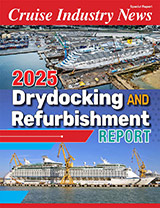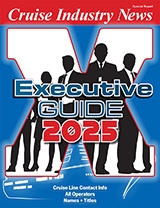Newly recapitalized Premier Cruises has significantly reshuffled its itineraries for 1999, according to executive vice president Hans Rood. The shifts became necessary after Premier signed a two-year charter deal with a consortium of time-share companies d/b/a Celebration Cruises for use of the 21,486-ton, 776-passenger OceanBreeze. As part of the deal, Premier will retain onboard revenues from the vessel but all passengers will be supplied via the participating time-share ventures, who promise their customers a cruise in return for taking a tour of their properties. The OceanBreeze is set to begin two-day Ft. Lauderdale-to-Bahamas sailings for Celebration Cruises on Jan. 11.
The charter deal, combined with general efforts to revise Premier’s fleet deployment, have resulted in the following changes for 1999/2000:
• The 31,793-ton, 1,146-passenger IslandBreeze is being pulled from its Canary Islands deployment as of Dec. 26. Reportedly, Canary Islands sailings had not sold well; COO Jon Erik Nygaard had previously voiced a plan to market this itinerary solely to European passengers, as opposed to a 50/50 European/ American mix, to address the problem.
Instead, the IslandBreeze will be shifted to the Caribbean for the remainder of the 1998-99 winter season, taking over the seven-night “Mayan” itinerary previously served by the 21,000-ton, 840-passenger SeaBreeze. The IslandBreeze will sail this Ft. Lauderdale-homeported itinerary until April 4, after which it is taken over for a full-ship Med charter by Thomson Holidays. Premier will then move the vessel back to the Canaries in the winter of 1999-2000, with a portion of the ship chartered by Thomson this time around (Thomson is moving its own Canary Islands vessel, the Topaz, to the Caribbean during the winter of 1999-2000, according to Rood).
• The SeaBreeze will be removed from its Mayan route to make room for the larger IslandBreeze, instead taking over the Montego-Bay Panama Canal itinerary vacated by the now-chartered OceanBreeze. The SeaBreeze will continue that route until April 4, after which it will reposition for five months of two- and five-day New England cruises out of New York City. The SeaBreeze’s itinerary beyond September 1999 has not been finalized.
• The 38,000-ton, 1,106-passenger Rembrandt will sail two new Ft. Lauderdale-Cozumel cruises this month before an 18-day repositioning cruise to Rio de Janeiro on Nov. 28. Between mid-December and early April, it will sail weekly cruises sold by South American tour operators.
She then returns for a summer in the Med with cabins partially chartered by Thomson. “After the Med next summer,” said Rood, “we will use the Rembrandt for longer itineraries. There will be a transatlantic crossing from Barcelona to Ft. Lauderdale, then a Panama Canal itinerary to Los Angeles, then two Hawaii cruises, followed by a Millennium Cruise to the Panama Canal.” While these itineraries are not finalized, Rood believes the ship will then sail a South America circumnavigation cruise to Ft. Lauderdale before returning to the Med in the summer of 2000. Unconfirmed reports also suggest that Premier is eyeing the Rembrandt for world cruises in the future.
The Rembrandt’s increased presence in the U.S. market has necessitated that Premier invest another $5 million for Federal Maritime Commission (FMC) bonding. Rood said this brings Premier’s total FMC bonding to the maximum $15 million.
• The itineraries of the 24,000-ton, 764-passenger Seawind Crown and the 38,700-ton, 1,116-passenger Oceanic will remain unchanged during 1999. However, Premier is planning to bring the Oceanic, Rembrandt and OceanBreeze together for a Millennium event inside the Panama Canal on Jan. 1, 2000. “Some people feel this may be a bit tricky, with it being the same day that the U.S. hands over the canal to Panama, plus questions computerwise (the Y2K glitch),” noted Rood, expressing confidence that the three-ship event would be pulled off successfully.
Rood also addressed the speculation that Premier was considering a shift of one of its vessels to join its most successful vessel, the Oceanic, out of Port Canaveral, as a second Big Red Boat. Rood maintained that adding another Big Red Boat would require Premier to acquire a new vessel, as opposed to merely repainting an existing one. And additional acquisitions, believe most fmancial analysts, are not a part of Premier’s near-term future.
The timing of the latest itinerary shifts have nothing to do with the recent recapitalization plan, according to Rood. “It just happened that way, that we were able to charter the OceanBreeze when we were. It just all fell into place.” (In fact, the itinerary changes were finalized just days after Premier unveiled its new 1999 schedule brochures, which are now obsolete).
Of the recent developments at Premier, Rood admitted that “we’ve had a lot of publicity lately, not necessarily of the type that is best for brand building.” But the recapitalization deal and the new $21 million in fmancing “should give no reason to the travel trade to doubt us,” he believes. “We’re working very hard right now to regain the travel trade’s trust.”



